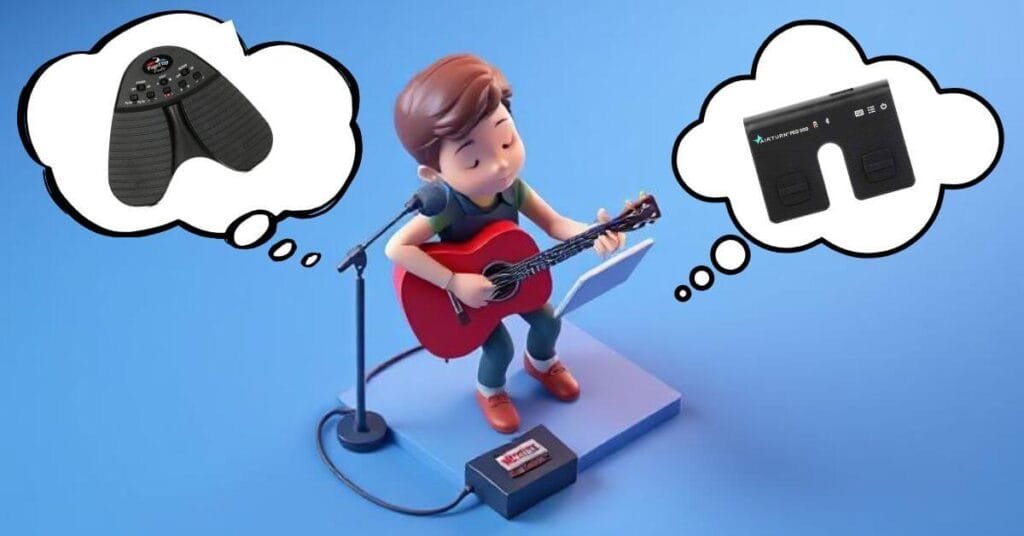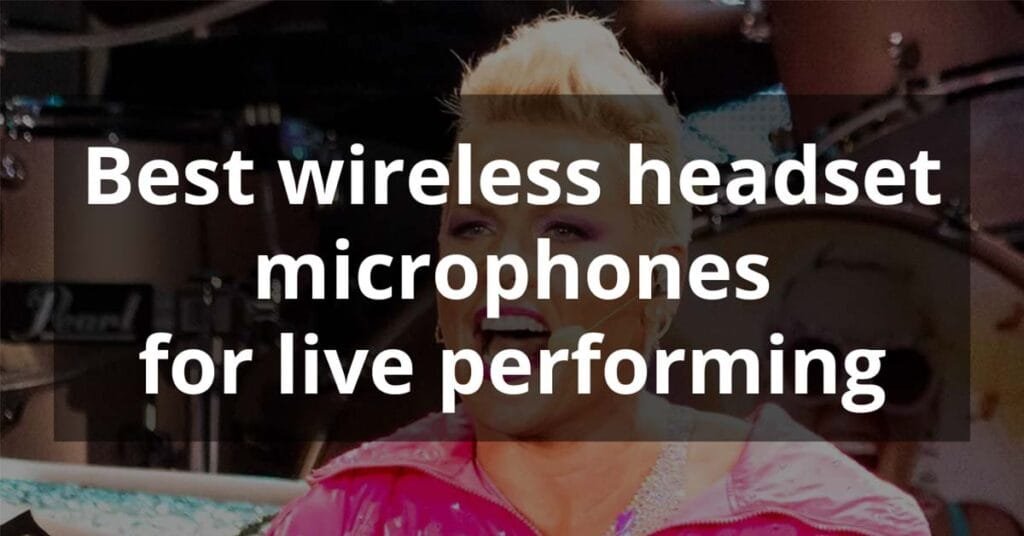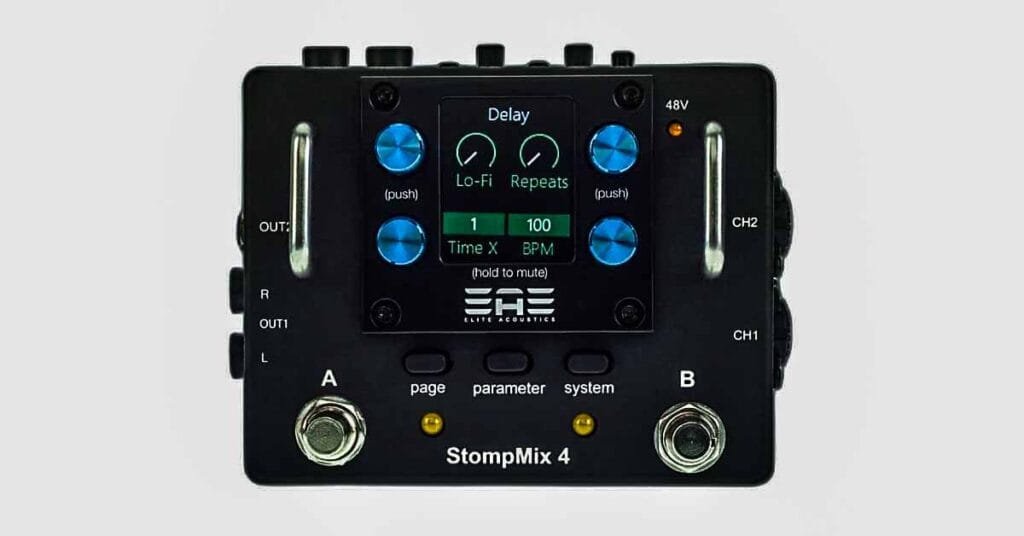Best Bluetooth Page Turners for Every Type of Gig
Bluetooth page turners are changing the way musicians play gigs. All types of musicians can benefit from using these simple hands-free devices.
But they are not all the same. In this article, we will talk about all the specific features a page-turner should have for different types of musical performances or presentations.
This is a one-stop article for those looking for the best page-turner for their needs. I have used about half of the models that are mentioned here and have done deep research on the ones I haven’t used, to give you an honest opinion on which models would work best for different performance situations.
What is a Bluetooth Page Turner?
A Bluetooth Page Turner is a small device for scrolling and flipping digital pages on tablets, phones, and computers using Bluetooth wireless technology for hands-free use. It is the perfect tool for musicians and all types of presenters. Pedals or buttons on page turners can also be customized to trigger MIDI, lighting, and other events.
Why do musicians need a Bluetooth page-turner?
One of the most annoying things during a gig is dealing with sheet music, lyrics, and chords on paper. So we made it all available in a digital form using a tablet or phone. But then we realized that it’s not easy to scroll down while our hands are playing an instrument.
Voila! The Bluetooth page-turner was born. Now, with only a footstep, we can scroll down, up, flip to the next song, and even start a backing track without ever needing to use our hands.
How does a Bluetooth page turner work?
The whole process is very straightforward. First, the page-turner needs power. They can use batteries that can be replaceable or built-in or be powered via a 9V power input from your pedalboard or separate adapter.
After turning it on, the page-turner needs to be connected to i.e. your iPad via Bluetooth. Don’t forget to turn on Bluetooth on your iPad! The device will show up on your iPad’s Bluetooth settings; all you have to do is select it. After that, the two devices are synced.
The default settings for all page-turners are the previous page and the next page. If you need it to do something else you can now select a different mode, which most page-turners have.
Important: There are two ways page-turners can connect with other devices.
- Directly using only Bluetooth
- Using the page-turners app
Benefits of using a Bluetooth page-turner
1. Hands-Free
Bluetooth page turners offer many advantages that can significantly enhance how we perform a concert or learn. The biggest benefit is the ability to easily transition between pages without affecting the flow of music. This allows us to stay focused on our performance rather than being distracted by manually flipping pages.
2. Versatility
The second main benefit that Bluetooth page turners provide is their versatility. They are compatible with almost all applications and platforms made for musicians and more. This ability makes it possible to change between different apps seamlessly, which allows access to a vast library of digital music.
Versatility goes beyond just scrolling and flipping pages during performances. Many page-turners can be customized to send all kinds of messages to various devices, not just those with lyrics and sheet music. Bluetooth page turners can become full-blown MIDI controllers that can control effects pedals, backing tracks, and lighting scenes.
3. Wireless
The hands-free feature is a huge benefit on its own. This can be achieved with a wired solution as well, but the fact that a page-turner can be placed anywhere where we find it convenient for us is a major plus. It can be placed anywhere we choose, to the left, right, or lifted for easier use when sitting on a stool.
4. Portability
Most page-turner models are lightweight and compact, making them easy to transport to gigs or rehearsals. Their size and weight are less than a standard guitar pedal so it’s like we’re not adding additional gear to our rig.
Factors to consider when choosing a Bluetooth page-turner
1. Compatibility
Make sure that the page-turner that fits your needs is compatible with your preferred device type (iOS, Android, PC) and the application you are using.
2. Number of pedals and MIDI
The most common page-turners have 2 pedals, but those with advanced functionality have 4 and up to 6 pedals or buttons.
These buttons can be used for various functions:
- Scroll down, up
- Next or previous page
- Start and stop playback (backing tracks)
- MIDI commands
- Handsfree recording control for DAWs
- Various customizable functions: Jump to section, next setlist,…
3. Battery life
Page-turners that have longer-lasting built-in battery life are an important feature for those who use them on a daily basis. Performances can last for hours, anywhere from 2 to 6 sometimes. Some models offer rechargeable batteries, while some use replaceable batteries.
Which type is better? It’s up to you. Some like having the ability to change physical batteries in real time if they die, but then, you have to keep on buying them. On the other hand, built-in rechargeable batteries are more convenient, but if they get empty during a gig, no page-turner for you. In most cases, page-turners have light indicators that light up hours before the batteries are gone.
4. Pedal (Button) type
After spending a short time looking for page turners online you will notice that there are two main button types: the flat low-profile pedal with a wide surface and the small button type used on guitar pedals. Some page-turners like the iRig Blue Turn fall in a category somewhere in between.

5. Ergonomics (Design)
This should not be overlooked. The last thing you want is to find out that the page-turner that has all the features you need is not suitable for your needs because of its ergonomics.
You should be able to easily operate your page-turner with your feet, without needing to look down. Musicians who play classical music usually won’t need any other pedal than a page-turner so a wider-typed pedal is best because it’s only one pedal, so why not make it hard to miss.
Guitarists, on the other hand, use many pedals fitted on a pedalboard. Adding an additional pedal as a page-turner can make it hard to use if not planned properly. The page-turner’s size is important if it is fitted on a pedalboard.
A simple 2-button small page-turner doesn’t take much space on a pedalboard.
6. Built quality
If you gig frequently and play outdoors, look for rugged designs with metal housings. The lighter plastic models are good enough for occasional or home use.
7. Responsiveness
The responsiveness of the page turner is crucial for seamless performance. Latency or delay in turning pages should be minimal. Look for page turners that make pages turn in real-time with no noticeable delay.
8. Slip factor
Every page-turner has bottom surfaces with different anti-slipping materials and sizes. This is not that important for everyone, but if you play a lot of outdoor gigs on tiles this can be very annoying.
Best Page-Turners for different types of performers
There are different performing situations where specific page-turner features come in handy.
1. Classical music performers (no other pedals)

Musicians who play classical music or don’t use other pedals for effects don’t have to bother about space in front of them. One page-turner, even the largest models, like the ones that come from PageFlip, will not get in the way. Because of the pedal’s ergonomics, precise foot pressing is done with ease.

Big, but easy to operate due to ergonomics.
Another very important factor for classical music players is that a page-turner should be silent. If you are the type of performer who needs a silent page-turner these are good choices:
- Airturn Duo 500
- Pageflip-all models: Butterfly, Firefly, & Dragonfly
- Ik Multimedia iRig BlueTurn
2. Touring Musicians
If you are a touring musician that plays energetic shows you will need a page-turner that can take a beating. Another feature that comes in handy is a 9V supply. This is great for integrating page-turners with your existing pedalboard.

The Stomp from Coda Music is the most durable model available. The manufacturer states that it has a durable road-ready metal body. It also comes with a 9V DC power supply option or you can use a 9V battery which is replaced by unscrewing the back of the device. There is also a USB terminal located at the back to keep your phone or tablet fully charged when using the power supply.

All the Airturn BT500S models are also very good for touring musicians. Their molded case is made from a polymer blend that Airturn states to be “nearly indestructible” and doesn’t interfere with radio signals.
Touring musicians also need MIDI compatibility, which these devices have. Page turners with 4 or 6 buttons are often used for this.
These page-turners are in fact, pedalboard-ready stompboxes:
- Coda Music Stomp
- Airturn BT500S-2, BT500S-4, & BT500S-6
- Airturn older BT200S series
3. Standing vs sitting musicians
The thinnest page-turner is the older Airturn PedPro. But it’s very hard to press. You have to use your body weight to turn a page. It’s useless if you’re sitting on a stool. I got muscle inflammation using it while sitting on a stool.
When using a certain technique that you have to get used to, the Airturn Pedpro works, but you have to be standing. The pedal is robust, and it is so thin that you can fit it under your pedalboard so it takes up less space in front of you.

In other words, most page-turners will work fine if you are a standing musician and don’t play classical music.
Musicians who perform sitting on a stool typically have their feet raised from the ground. Some page-turners like the Airturn Pedpro are very hard to press while in this position. I’ve tried this, and would not recommend it to acoustic solo performers.

Because of the elevated position of your feet, you can’t use your weight to press a footswitch, so you need a page-turner with buttons that are easy to press.
The new PED 500 from Airturn has an upgraded pedal design with raised footswitches, where you can feel a foot vibration that lets you know it has been pressed properly. This is a major selling point for sitting musicians.

Best Bluetooth page turners for sitting performers:
- Airturn PED 500
- Airturn BT500S and BT200S series
- Coda Music Stomp
- IK Multimedia iRig BlueTurn
Best Page Turners
1. Best overall: Airturn DUO 500
The DUO is Airturn’s flagship model and probably the best-selling professional-grade page-turner. It is thicker than the PED models but still very lightweight. The pedals are absolutely silent, very easy to navigate, and with minimal latency.
Those who need a professional page turner with pedals that are spaced further from each other should not look further.
The Airturn DUO is compatible with all platforms, and apps, and is customizable to do all you could ever need.
Airturn DUO 500

Professional silent Page turner
Main Features:
Pros:
Cons:
2. Best for pedalboards: Airturn BT500S-2
The Airturn BT500S-2 is the perfect page turner for gigging musicians who want minimalistic and practical gear. It is the one with the smallest footprint in this list. The stompbox design with small metal footswitches will look great on your pedalboard.
If you ever need to use MIDI commands or control backing tracks, the BT500S-2 can do it all. The switches are not completely silent, but this is not an issue for pop-rock and louder genres.
Airturn BT500S-2

Smallest 2-button page-turner for pedalboard
Main Features:
Pros:
Cons:
3. Best for Touring musicians: Coda Music Stomp
This page-turner has a similar stompbox design as the Airturn BT500S-2 but is larger and heavier due to its metal housing that is designed to withstand all types of touring conditions.
The additional USB port for charging tablets and phones is a plus.
Coda Music Stomp

Best Stompbox page-turner for touring musicians
Main Features:
Pros:
Cons:
4. Best professional slim page turner: Airturn PED 500
The Airturn PED 500 is the newly released page-turner that is the new improved version of the imperfect PedPro. It has original newly-designed tactile footswitches that slightly vibrate when properly pressed.
Based on new reviews, this page turner could easily become the new standard very soon. It has the ergonomic slim deisgn as its predecessor but with improved footswitches making it the perfect choice for musicians looking for a device with minimal height and weight.
Airturn PED 500

Airturn’s much improved version of the Ped Pro
Main Features:
Pros:
Cons:
5. Best for Piano and Keyboard: Pageflip Butterfly
When looking at the Pageflip series of page turners, it’s clear that the company had the good old analog foot pedal in mind. The ergonomics are simple and make the pedals hard to miss thanks to their size and the angle at which they are placed.
The anti-slip pad at the bottom ensures the pedal in place very nicely. It runs on 2 AA batteries that last forever, and if for some reason they stop working, a quick change of batteries and you’re ready to go.
The PageFlip Butterfly is the company’s entry model, but for those who want a classic-styled simple page-turner that will not let you down it is a winner.
Pageflip Butterfly

Professional silent Page-turner
Main Features:
Pros:
Cons:
6. Best simple page turner: iRig BlueTurn
The Blueturn differs from all the other page turners in this list. The first thing you will notice are the white buttons that are totally silent. When turned on, the buttons are backlit and are hard to miss.
Despite the plastic enclosure, I believe it could last a long time if carefully watched. In theory, it could be placed on a pedalboard, but since the power button is located on the bottom, this is not an option.
Even with these small imperfections, I would recommend this easy-to-use pedal to anyone who wants a simple affordable Bluetooth page-turner.
IK Multimedia iRig BlueTurn

Affordable and simple page turner
Main Features:
Pros:
Cons:
7. Best Budget Page Turner: Donner
The Donner is the cheapest Bluetooth page turner in this list, but nevertheless does a good job. It’s resemblance to the Airturn DUO 500 is obvious. The material is not the same as in the DUO but still seems very robust and reliable.
The only con is the battery’s life which is 50 hours. Other than that, the Donner page-turner is the cheapest alternative to the Airtun DUO 500.
Donner Page Turner

Best cheaper alternative for Airturn DUO 500
Main Features:
Pros:
Cons:
Conclusion
Investing in a good Bluetooth page-turner can make your gigging experience a breeze. The benefits of Bluetooth hands-free technology, and simple customizable features, make these devices an essential tool for every musician.
Say goodbye to papers and manual page turning of tablets. With a reliable page-turner, performers can focus on what truly matters, their music.
Before selecting the best page-turner for your needs, consider the main features such as battery life, ergonomic design, responsiveness, and versatility.




